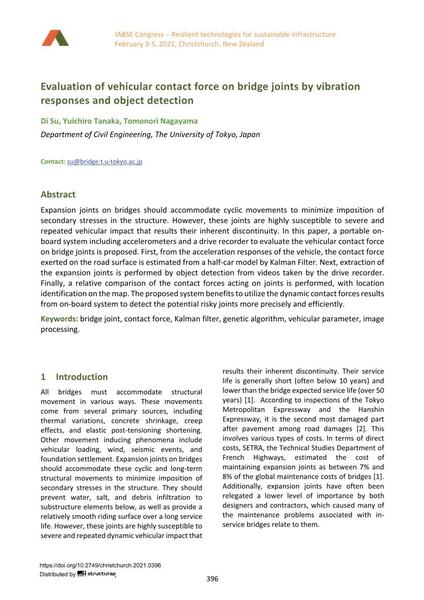Evaluation of vehicular contact force on bridge joints by vibration responses and object detection

|
|
|||||||||||
Bibliographic Details
| Author(s): |
Di Su
(Department of Civil Engineering, The University of Tokyo, Japan)
Yuichiro Tanaka (Department of Civil Engineering, The University of Tokyo, Japan) Tomonori Nagayama (Department of Civil Engineering, The University of Tokyo, Japan) |
||||
|---|---|---|---|---|---|
| Medium: | conference paper | ||||
| Language(s): | English | ||||
| Conference: | IABSE Congress: Resilient technologies for sustainable infrastructure, Christchurch, New Zealand, 3-5 February 2021 | ||||
| Published in: | IABSE Congress Christchurch 2020 | ||||
|
|||||
| Page(s): | 396-403 | ||||
| Total no. of pages: | 8 | ||||
| DOI: | 10.2749/christchurch.2021.0396 | ||||
| Abstract: |
Expansion joints on bridges should accommodate cyclic movements to minimize imposition of secondary stresses in the structure. However, these joints are highly susceptible to severe and repeated vehicular impact that results their inherent discontinuity. In this paper, a portable on- board system including accelerometers and a drive recorder to evaluate the vehicular contact force on bridge joints is proposed. First, from the acceleration responses of the vehicle, the contact force exerted on the road surface is estimated from a half-car model by Kalman Filter. Next, extraction of the expansion joints is performed by object detection from videos taken by the drive recorder. Finally, a relative comparison of the contact forces acting on joints is performed, with location identification on the map. The proposed system benefits to utilize the dynamic contact forces results from on-board system to detect the potential risky joints more precisely and efficiently. |
||||
| Keywords: |
genetic algorithm image processing bridge joint contact force Kalman filter vehicular parameter
|
||||
